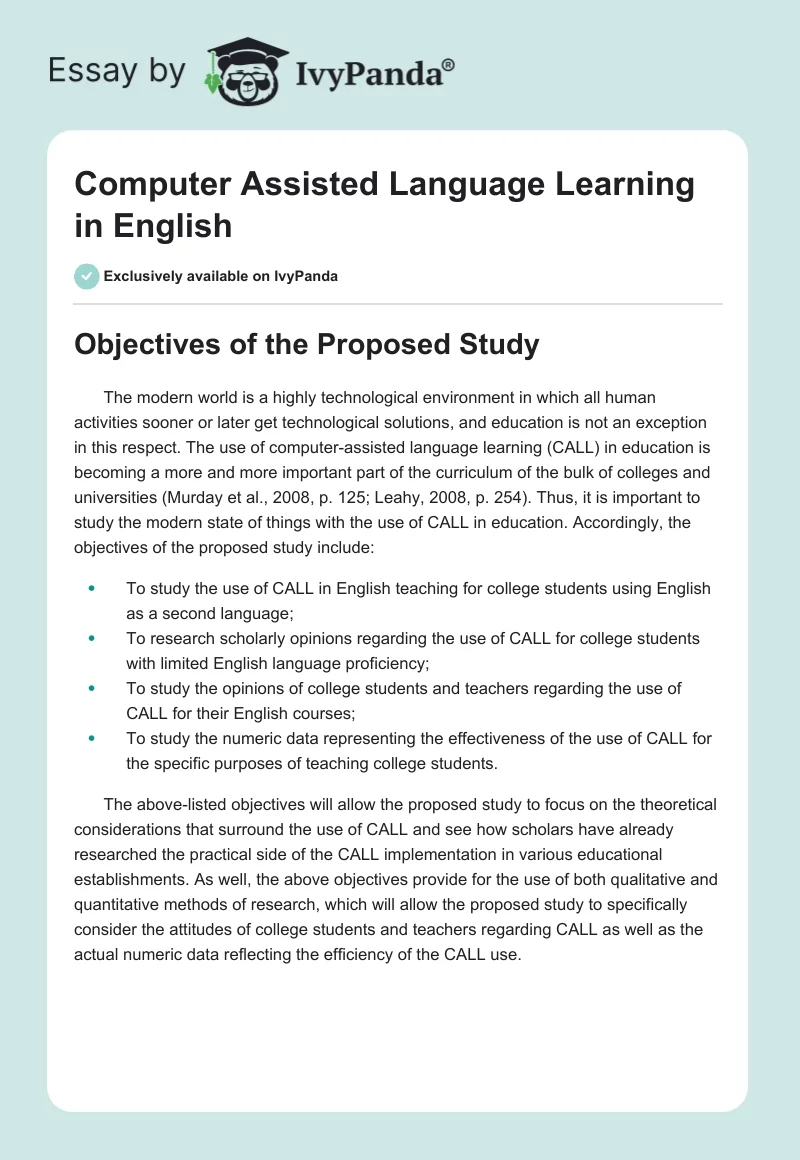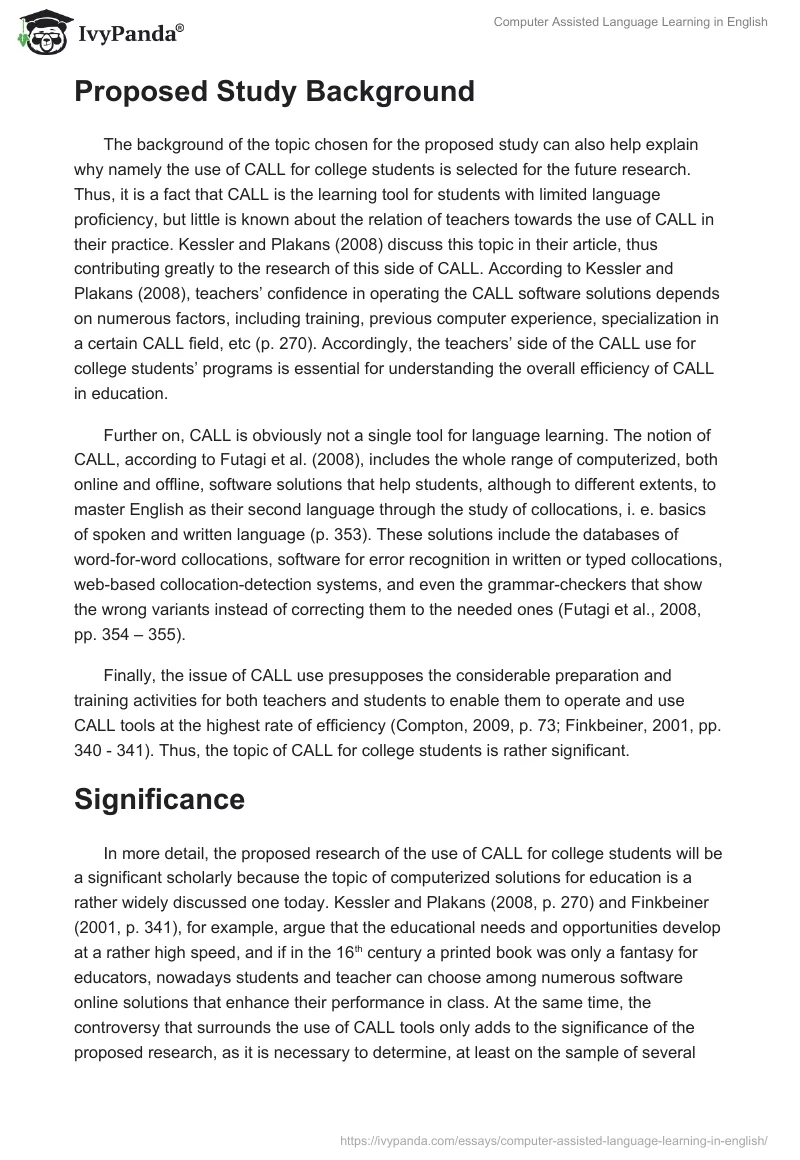Objectives of the Proposed Study
The modern world is a highly technological environment in which all human activities sooner or later get technological solutions, and education is not an exception in this respect. The use of computer-assisted language learning (CALL) in education is becoming a more and more important part of the curriculum of the bulk of colleges and universities (Murday et al., 2008, p. 125; Leahy, 2008, p. 254). Thus, it is important to study the modern state of things with the use of CALL in education. Accordingly, the objectives of the proposed study include:
- To study the use of CALL in English teaching for college students using English as a second language;
- To research scholarly opinions regarding the use of CALL for college students with limited English language proficiency;
- To study the opinions of college students and teachers regarding the use of CALL for their English courses;
- To study the numeric data representing the effectiveness of the use of CALL for the specific purposes of teaching college students.
The above-listed objectives will allow the proposed study to focus on the theoretical considerations that surround the use of CALL and see how scholars have already researched the practical side of the CALL implementation in various educational establishments. As well, the above objectives provide for the use of both qualitative and quantitative methods of research, which will allow the proposed study to specifically consider the attitudes of college students and teachers regarding CALL as well as the actual numeric data reflecting the efficiency of the CALL use.
Proposed Study Background
The background of the topic chosen for the proposed study can also help explain why namely the use of CALL for college students is selected for the future research. Thus, it is a fact that CALL is the learning tool for students with limited language proficiency, but little is known about the relation of teachers towards the use of CALL in their practice. Kessler and Plakans (2008) discuss this topic in their article, thus contributing greatly to the research of this side of CALL. According to Kessler and Plakans (2008), teachers’ confidence in operating the CALL software solutions depends on numerous factors, including training, previous computer experience, specialization in a certain CALL field, etc (p. 270). Accordingly, the teachers’ side of the CALL use for college students’ programs is essential for understanding the overall efficiency of CALL in education.
Further on, CALL is obviously not a single tool for language learning. The notion of CALL, according to Futagi et al. (2008), includes the whole range of computerized, both online and offline, software solutions that help students, although to different extents, to master English as their second language through the study of collocations, i. e. basics of spoken and written language (p. 353). These solutions include the databases of word-for-word collocations, software for error recognition in written or typed collocations, web-based collocation-detection systems, and even the grammar-checkers that show the wrong variants instead of correcting them to the needed ones (Futagi et al., 2008, pp. 354 – 355).
Finally, the issue of CALL use presupposes the considerable preparation and training activities for both teachers and students to enable them to operate and use CALL tools at the highest rate of efficiency (Compton, 2009, p. 73; Finkbeiner, 2001, pp. 340 – 341). Thus, the topic of CALL for college students is rather significant.
Significance
In more detail, the proposed research of the use of CALL for college students will be a significant scholarly because the topic of computerized solutions for education is a rather widely discussed one today. Kessler and Plakans (2008, p. 270) and Finkbeiner (2001, p. 341), for example, argue that the educational needs and opportunities develop at a rather high speed, and if in the 16th century a printed book was only a fantasy for educators, nowadays students and teacher can choose among numerous software online solutions that enhance their performance in class. At the same time, the controversy that surrounds the use of CALL tools only adds to the significance of the proposed research, as it is necessary to determine, at least on the sample of several dozens of people, what is the actual effect of CALL on students’ performance and teachers’ confidence in class.
Methods
Finally, it is necessary to define the methodological approaches that will be used during the proposed study. As far as the research of the CALL use for college students will involve the direct work with people and the analysis of purely numeric data, the combination of qualitative and quantitative methods will be implemented. As Golafshani (2003, p. 597) claims reliability and validity to have critical meaning for any research, the proposed study will also be developed based on these concepts.
In more detail, the qualitative part of the methodology for the proposed study will include the review of the previous research works on the topic of CALL in education, the analysis of those works, the conduct of interviews and surveys of students and teachers. The sole aim of all the implemented qualitative methods will be to study the attitudes of students and teachers towards the use of CALL in their practices and assess, at least approximately, the efficiency of students’ and teachers’ performance while CALL methods are practiced. Golafshani (2003) defines qualitative research as “any kind of research that produces findings not arrived at utilizing statistical procedures or other means of quantification” (p. 600.). Accordingly, the qualitative methods listed above will deal more with the implications of the findings, rather than with their numerical meanings.
The use of the quantitative method in the proposed research will be limited to two main processes. First, the results of surveys of CALL effectiveness will be presented in the numeric form in relation to the measurements scale that will allow seeing whether a figure displayed by a student reflects the high, moderate, or low. These data will then be related to the effectiveness of students’ and teachers’ performance without CALL. Finally, both data sets will be compared and respective conclusions on the efficiency and overall necessity of CALL methods in language learning for college students will be made.
The reliability of both qualitative and quantitative methods will be supported by the objective data about the academic performance of studies students before and after CALL implementation. The validity of the research methods will be ensured through the proper sampling that will include all groups of students and teachers according to their approximate psychological, educational, personal, and professional characteristics.
References
Compton, Lily K. L. (2009). Preparing language teachers to teach language online: a look at skills, roles, and responsibilities. Computer Assisted Language Learning, 22(1), 73 — 99.
Finkbeiner, C. (2001). One and All in CALL? Learner-Moderator-Researcher. Computer Assisted Language Learning, 14(3), 339 — 361.
Futagi, Y., Deane, P., Chodorow, M., and Tetreault, J. (2008). A computational approach to detecting collocation errors in the writing of non-native speakers of English. Computer Assisted Language Learning, 21(4), 353 — 367.
Golafshani, N. (2003). Understanding reliability and validity in qualitative research. The Qualitative Report, 8(4), 597-606. Web.
Kessler, G. and Plakans, L. (2008). Does teachers’ confidence with CALL equal innovative and integrated use? Computer Assisted Language Learning, 21(3), 269 — 282.
Leahy, C. (2008). Learner activities in a collaborative CALL task. Computer Assisted Language Learning, 21(3), 253 — 268.
Murday, K., Ushida, E., and Ann Chenoweth, N. (2008). Learners’ and teachers’ perspectives on language online. Computer Assisted Language Learning, 21(2), 125 — 142.


